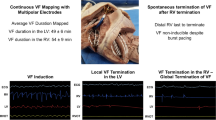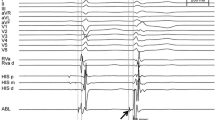Abstract
Introduction: Shocks given during the vulnerable period of cardiac repolarization may induce ventricular fibrillation (VF). However, the relationship of the vulnerable period and the monophasic action potential (MAP) has not yet been reported in humans. The purpose of this study was, therefore, to determine how the monophasic action potential recorded from the right ventricle correlates with inducibility of VF using T wave shocks during ventricular pacing.
Methods: Eleven patients undergoing implantable cardioverter defibrillator (ICD) implantation had a MAP catheter positioned in the right ventricle (RV). The local monophasic action potential duration at 90% repolarization (MAP90) duration was measured during pacing at 400 ms. VF induction was attempted by pacing at 400 ms for 10 cycles and then giving a 1.0 joule monophasic T wave shock at varying coupling intervals (CI) to the last paced stimulus. The maximum and minimum CI that induced VF were determined and mapped in relation to the MAP90 recording.
Results: The average paced MAP duration was 275 ± 20ms. The minimum and maximum CI to induce VF were 255 ± 24ms and 325 ± 36ms respectively. This ranged from 93% to 118% of the MAP90 duration but because of delay in conduction time to the MAP catheter, shocks that induced ventricular fibrillation occurred between 74% and 99% of local repolarization time.
Conclusion: VF is inducible with low energy T wave shocks falling during the last 25% of the right ventricular MAP90 recording. This corresponds with VF initiation during phase III repolarization.
Similar content being viewed by others
References
Wiggers CJ, Wegria R. Ventricular fibrillation due to single localized induction and condenser shocks applied during the vulnerable phase of ventricular systole. Am J Physiol 1940;128:500–505.
Hoffman BF, Gorin EP, Wax FS, Siebens AA, Brooks CM. Vulnerability to fibrillation and the ventricular-excitability curve. Am J Physiol 1951;167:88–94.
Swerdlow CD, Martin DJ, Kass RM, Davie S, Mandel WJ, Gang ES, Chen P-S. The zone of vulnerability to T wave shocks in humans. J Cardiovasc Electrophysiol 1997;8: 145–154.
Hou CJ-Y, Chang-Sing P, Flynn E, Martinez L, Peterson J, Ottoboni LK, Liern LB, Sung RJ. Determination of ventricular vulnerable period and ventricular fibrillation threshold by use of T-wave shocks in patients undergoing implantation of cardioverter/defibrillators. Circulation 1995;92:2558–2564.
Malkin RA, Idriss SF, Walker RG, Ideker RE. Effect of rapid pacing and T-wave scanning on the relation between the defibrillation and upper-limit-of-vulnerability dose-response curves. Circulation 1995;92:1291–1299.
Chen P-S, Feld GK, Kriett JM, Mower MM, Tarazi RY. Fleck P, Swerdlow CD, Gang ES, Kass RM. Relation between upper limit of vulnerability and defibrillation threshold in humans. Circulation 1993;88:186–192.
Behrens S, Li C, Franz MR. Timing of the upper limit of vulnerability is different for monophasic and biphasic shocks: Implications for the determination of the defibrillation threshold. PACE 1997;20:2179–2187.
Swerdlow CD, Ahern T, Kass RM, Davie S, Mandel WJ, Chen P-S. Upper limit of vulnerability is a good estimator of shock strength associated with 90% probability of successful defibrillation in humans with transvenous implantable cardioverter-defibrillators. J Am Coll Cardiol 1996;27: 1112–1118.
Hwang C, Swerdlow CD, Kass RM, Gang ES, Mandel WJ, Peter CT, Chen P-S. Circulation 1994;90:2308–2314.
Franz MR, Burkhoff D, Spurgeon H, et al. In vitro validation of a new cardiac catheter technique for recording of monophasic action potentials. Eur Heart J 1986;7:34–41.
Franz MR. Method and theory of monophasic action potential recording. Prog Cardiovasc Diseases 1991;33:347–368.
Fabritz CL, Kirchof PF, Behrens S, Zabel M, Franz MR. Myocardial vulnerability to T wave shocks: Relation to shock strength, shock coupling interval, and dispersion of ventricular repolarization. J Cardiovasc Electrophysiol 1996;7:231–242.
Author information
Authors and Affiliations
Rights and permissions
About this article
Cite this article
Shepard, R.K., Wood, M.A., Dan, D. et al. Induction of Ventricular Fibrillation by T Wave Shocks: Observations from Monophasic Action Potential Recordings. J Interv Card Electrophysiol 3, 335–340 (1999). https://doi.org/10.1023/A:1009835903873
Issue Date:
DOI: https://doi.org/10.1023/A:1009835903873




